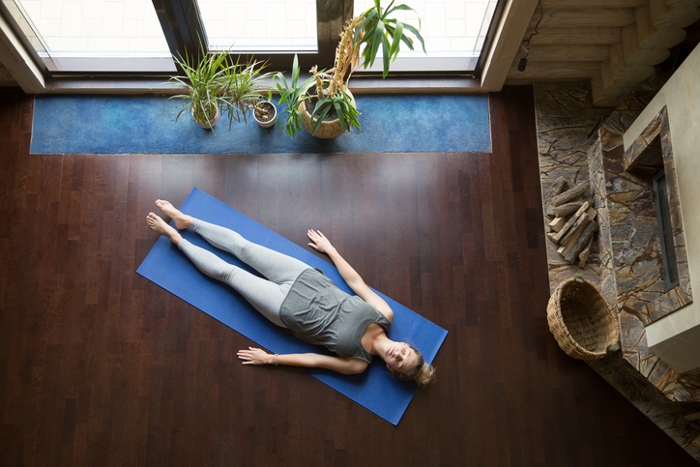Here is a free, step-by-step progressive muscle relaxation exercise that you can teach your clients. First, check out Edmund Bourne’s guidelines for practicing PMR effectively. You’ll want to share these with your clients before and after you teach them the exercise.
An excerpt from Coping with Anxiety: Ten Simple Ways to Relieve Anxiety, Fear, and Worry
Once you are comfortably supported in a quiet place, follow the steps below:
1. To begin, take three deep abdominal breaths, exhaling slowly each time. As you exhale, imagine the tension throughout your body beginning to go away.
2. Clench your fists. Hold for seven to ten seconds and then release for fifteen to twenty seconds. Use these same time intervals for all other muscle groups.
3. Tighten your biceps by drawing your forearms up toward your shoulders and making a muscle with both arms. Hold…and then relax.
4. Tighten your triceps, the muscles on the undersides of your upper arms, by extending your arms out straight and locking your elbows. Hold…and then relax.
5. Tense the muscles in your forehead by raising your eyebrows as far as you can. Hold…and then relax. Imagine your forehead muscles becoming smooth and limp as they relax.
6. Tense the muscles around your eyes by clenching your eyelids tightly shut. Hold…and then relax. Imagine sensations of deep relaxation spreading all around the area of your eyes.
7. Tighten your jaws by opening your mouth so widely that you stretch the muscles around the hinges of your jaw. Hold…and then relax. Let your mouth open and allow your jaw to hang loose.
8. Tighten the muscles in the back of your neck by pulling your head way back, as if you were going to touch your head to your back (be gentle with this muscle group to avoid injury). Focus only on tensing the muscles in your neck. Hold…and then relax. Since this area is often especially tight, it’s good to do this tense-relax cycle twice.
9. Take a few deep breaths and tune in to the weight of your head sinking into whatever surface it is resting on.
10. Tighten your shoulders by raising them up as if you were going to touch your ears. Hold…and then relax.
11. Tighten the muscles around your shoulder blades by pushing your shoulder blades back as if you were going to touch them together. Hold the tension in your shoulder blades…and then relax. Since this area is often especially tense, you might repeat this tense- relax sequence twice.
12. Tighten the muscles of your chest by taking in a deep breath. Hold for up to ten seconds…and then release slowly. Imagine any excess tension in your chest owing away with the exhalation.
13. Tighten your stomach muscles by sucking your stomach in. Hold…and then release. Imagine a wave of relaxation spreading through your abdomen.
14. Tighten your lower back by arching it up. (You can omit this part of the exercise if you have lower back pain.) Hold…and then relax.
15. Tighten your buttocks by pulling them together. Hold…and then relax. Imagine the muscles in your hips going loose and limp.
16. Squeeze the muscles in your thighs all the way down to your knees. You will probably have to tighten your hips along with your thighs, since the thigh muscles attach at the pelvis. Hold…and then relax. Feel your thigh muscles smoothing out and relaxing completely.
17. Tighten your calf muscles by pulling your toes toward you ( ex carefully to avoid cramps). Hold…and then relax.
18. Tighten your feet by curling your toes downward. Hold…and then relax.
19. Mentally scan your body for any residual tension. If a particular area remains tense, repeat one or two tense- relax cycles for that group of muscles.
20. Now imagine a wave of relaxation slowly spread- ing throughout your body, starting at your head and gradually penetrating every muscle group all the way down to your toes.
The entire progressive muscle relaxation sequence should take twenty to thirty minutes the first time. With practice, you may decrease the time needed to fifteen to twenty minutes. You might want to record an audio file of the above exercise on your preferred electronic device (smartphone, tablet, or laptop) to expedite your early practice sessions. You can do this in your own voice or someone else’s voice, if you prefer. You might also wish to obtain a professionally made recording of the progressive muscle relaxation exercise. One such recording is available as a companion download for The Anxiety and Phobia Workbook, sixth edition. A search of “progressive muscle relaxation” at Amazon.com should yield a number of recorded versions on CDs or as digital audio files.


 2024 Peace Playbook: 3 Tactics to Avoid Clashes with Your Partner
2024 Peace Playbook: 3 Tactics to Avoid Clashes with Your Partner